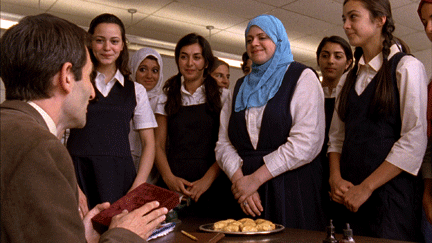
Classroom scene from “Santa Claus in Baghdad.” The book in the professor’s hand is a red velvet volume on Kahlil Gibran, published in 1984. In the film it contains an inscription from the professor’s professor dated 1949. Mixing dates is not the only cinematic sin of this problematic “educational” film.
Last week I received an email as an “educator” about a new, award-winning short feature film called Santa Claus in Baghdad. The announcement came from the filmmaker, an Egyptian named Raouf Zaki, who provided a free preview on a website called vimeo.com. The film is based on a short story of the same name, now part of a series of short stories for young adults by author Elsa Marston. I must admit that I found the title a bit strange, so I decided to look at the preview Tuesday night. But, as the old Christmas song expresses so well, “When, what to my wondering eyes should appear?” A turkey; nothing to give thanks for in battling stereotypes of Iraqis. I realize that the film intended to humanize Arab children, but it tells an emotional “what a great kid” story unrelated to the realities of living in Iraq. Iraqi children, including the thousands who died during Saddam’s regime and during the American occupation, deserve better.
What do I find wrong with the film, apart from just about everything? First, the plot. A little Iraqi boy who dreams of Santa Claus bringing him a toy red car. An Iraqi professor of Arabic literature who is devoted to Kahlil Gibran’s writing on “freedom” underneath the menacing classroom portrait of Saddam Hussein. The catty middle school jealousy of school girls as a universal truth. A visiting uncle from America who brings a whole suitcase full of gifts, but only has room for medicine, the labels of which he reads out loud, proudly announcing what bargain prices he paid. Second, what is left out. Nowhere in the film do we encounter Islam, apart from a staged minaret and an Egyptian preacher over a loudspeaker. Although not stated explicitly, the boy’s interest in Santa Claus, the extolling of Gibran, and a wall painting that looks like the Virgin Mary suggest that this is a Christian Iraqi family. Were this a story about Palestine or Lebanon, this sectarian selectivity would fit. But this is supposed to be Iraq. Nor is there any suggestion of the brutality of Saddam’s regime. The film utterly ignores politics, as though it should not matter. Yet the cinematic sublimation has Saddam looking down on the children in every classroom scene. Third, shall I mention the really awful acting, accents that are not Iraqi, and that Boston does not become Baghdad, camera tricks notwithstanding. Even interspersing general scenes from Cairo does not give the children watching a magic carpet to Rashid Street. If anything “Arab” goes for the filmmaker, then this film only perpetuates the stereotypes. If you watched the film and then went to Baghdad, you would not know where you are.
A concerted effort is being made to make this half-hour film available to public schools, with a promotion blitz of a “substantially discounted price.” The DVD includes a study guide, put together by Barbara Petzen, a graduate student who is touted on the website as “presently head of the Middle Eastern Outreach Council in Washington, D.C.” In fact she is education director, a staff member and not the head, and it is the Middle East Policy Council. Quibbling, perhaps, but such inaccuracies on the website suggest a pattern of carelessness evident throughout the film. Ms. Petzen is assisted by a children’s writer, the story’s author and a primary school math and science teacher of Lebanese-American origin. The study guide is said to be appropriate for 8th grade to college level. I can’t imagine showing this film to a college class, let alone one in Anthropology (one of the fourteen fields listed). Would I pair it with The Red Balloon?
Normally, I would not bother to comment on a film intended for children. But here’s the problem: a film about Iraq with not a real Iraqi in sight, nor an established scholar advising that the film presents an imaginary view of modern Baghdad that denies the political realities surrounding poverty. There is nothing wrong with a film that brings Arabian Nights alive for a modern audience, but this film is being presented as of documentary value, providing an insight into the thinking of Iraqi children. This film does not show what it means to grow up in Iraq; it shows what a filmmaker dreams about after reading a silly short story and turning his camera on. Santa Claus in Saddam’s Iraq? Rudolph the Red-Nosed Reindeer in the Mahdi Army’s Iraq of today? What next, a film about Umar al-Khattab in Rochester?
It is not clear from the website where the funding for the film came from. I will assume that it is simply a do-good intention that ends up doing bad things. To the extent the film makes the characters seem like your next door neighbors or school chums, it does not humanize. Amalgamating cultural differences and the causal nexus of suffering in Iraq into a daydream for children can only make the reality of that suffering more distant from Americans. Sorry, Virginia or Boston or Cairo, but there is no American icon Santa Claus in Baghdad, nor should we try to set one up in the Green Zone of America’s public school curricula.
There are good films about Iraq out there. One of my favorites, presenting real Iraqis dealing with an all-too-real American military presence in the aftermath of an intolerable dictatorship, is Sinan Antoon’s About Baghdad. If you want something for children too young to appreciate the atrocities in Iraq, then stick with the 1001 Nights where at least the fantasy is served up as fantasy.
Daniel Martin Varisco